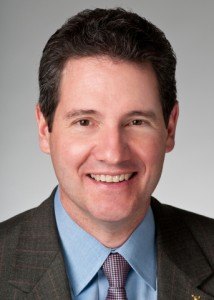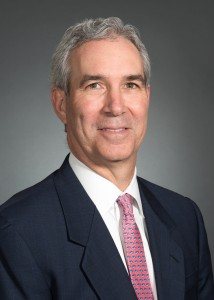Although small commercial insurance—outside of auto—is a top-line accelerator at The Hartford, auto insurance severity continues hitting the bottom line, say executives who expect a pretax $50 million prior-year reserve charge to impact fourth-quarter profits.
 Speaking at the Goldman Sachs Financial Services conference Wednesday, Hartford Chief Executive Officer Christopher Swift explained actions like the reserve charge and price changes designed to rein in future earnings troubles. But for the industry and the driving public, the issue of distracting technology—one factor fueling increased auto claim costs—needs to be addressed individually by the nation’s drivers.
Speaking at the Goldman Sachs Financial Services conference Wednesday, Hartford Chief Executive Officer Christopher Swift explained actions like the reserve charge and price changes designed to rein in future earnings troubles. But for the industry and the driving public, the issue of distracting technology—one factor fueling increased auto claim costs—needs to be addressed individually by the nation’s drivers.
“We’ve got a problem. We can fix it,” Swift said, referring not just to The Hartford’s battles to fix challenges in its personal and small commercial auto book. Between descriptions of pricing changes, expense cuts, class plan changes and agency force adjustments, the CEO delivered several pleas for societal change.
“I would implore this group as professionals in the investment management space [to] educate your friends, your family, your children on distracted driving. It is a real issue that’s causing real pain for society in general,” he told analysts near the start of his presentation.
Swift and Hartford President Douglas Elliot were clear throughout their talk that a confluence of factors has pushed the number of auto insurance accidents upward since late 2015, including lower unemployment and lower gas prices putting more drivers on the roads, driving more miles. But while the carrier has a better handle on frequency in late 2016, bodily injury severity trends have been tougher to read.
The executives highlighted two factors—technology and legal representation—as significant ones driving a “new normal” BI claims cost level that carriers are working to understand.
“There’s a lot of technology and a lot of distraction that is embedded in the car,” Swift said, making it clear that it isn’t just the devices that drivers bring with them into their vehicles that are contributing to more serious accidents occurring at high speeds.
“When we talk about speed of accidents, it’s not because everyone is driving faster. It’s because there’s less reaction time for braking ….That’s classic distracted driving,” he said.

“When we talk about speed of accidents, it’s not because everyone is driving faster. It’s because there’s less reaction time for braking ….That’s classic distracted driving.”
Christopher Swift
CEO, The Hartford
As for the added distraction of handheld devices, Swift repeated his plea. “We can teach ourselves to put down devices,” just as he learned to wear his seatbelt in the backseat of his father’s 1963 Chevy Impala after being bounced around enough without one, he said. “Put them down, get there safely, and then pick up back your activity. Teach everyone to do that.”
More Lawyers
Talking more generally about both increasing severity and frequency trends that started percolating in the second half of 2015, Swift said the trends continue to pressure 2016 results. “This team is working 24 by 7 to fix and improve this line of business,” he said. “We have adjusted our underwriting. We have shrunken our agency footprint. We have taken expense actions on operating expenses and we’ve also taken commission adjustments in what we pay our agents.”
The actions are beginning to take hold and “will begin to improve our 2017 combined ratios. As we head into ’18, we expect to get closer back to our target margins in this business going forward.”
But The Hartford isn’t near its target yet. In fact, Swift said that while he had guided analysts to a 101-103 combined ratio for personal auto insurance for 2016, “with these adjustments, we’re probably at the high end to slightly exceeding it,” he said, referring to the reserve adjustment that will be booked in the fourth quarter. Although the reserve boost, reflecting higher levels of bodily injury severity, relates to prior accident years—and primarily to accident year 2015—carriers peg their current year loss picks by referring to loss ratios for recent prior years.
The trends impacting accident-year 2015 “are pressuring us in ’16 also.”
Examining the immediate prior accident year for a fourth-quarter reserve study, Swift reported: “We have needed to make some adjustments to our severity calls for ’15—as we see with more severe accidents just a little more litigation and legal advice and counsel being sought as we settle out these claims.”
Adding some further insight on the $50 million reserve boost—split 40 percent to personal lines and 60 percent to commercial lines—Elliot said the commercial auto pressure is primarily centered in small commercial. For small-account commercial auto cases that are open in the 12–36 month range, “we are feeling pressure and severity to get them closed, and we’re seeing more litigation on the back side on the plaintiff end,” Elliot said. (Rate changes in excess of 30 percent over the last four years have shored up middle market commercial auto results, he said.)
“The pressure on severity is in bodily injury, tied in with speed and damageability of some of these accidents. But it’s a bit more challenged than we expected,” he said.
The unanticipated severity uptick is prompting adjustments to The Hartford’s underwriting approach along with higher loss picks, he said. “We have very automated systems in small commercial where we accept applications ‘on the glass’—through the computer with our agents. We have now changed our profile of what gets referred to an underwriter aggressively moving up, getting more touches on those auto, particularly standalone auto cases that have worked their way into our system,” Elliot said.
Pressed for more specifics higher legal costs in the small commercial auto book, Elliot said an increased percentage of open cases have attorney representation. “They’re putting pressure on awards, and [the awards] are slightly up from what they would be without attorney representation.”
He noted that the carrier also tracks the number of open claims in the quarter for which the case estimate moved up by more than $100,000. This number was higher than expected, he revealed.
Turning to personal lines, Elliot recalled that last year at this time, The Hartford was struggling with an uptick in frequency. “As we’ve worked our way through …our frequency picks are holding.” As in small commercial, “what we’re feeling is this continued pressure on severity,” he said, noting that ISO Fast Track for industry is showing the same stubborn patterns.
High Degree of Confidence
While the $50 million auto insurance reserve charge is a fraction of the more than $20 billion in property/casualty reserves carried on The Hartford’s balance sheet (as of Sept. 30, according to a financial supplement on the website) and roughly 5 percent of income through nine months, an analyst questioned whether similar reserve charges might have to be taken in the future. “Is this something you think about as a one-off?”
Swift commented on the thoroughness of the process of deriving the adjustment in his answer. “If you look at some of our actions that we’ve taken particularly on the accident year ’14 and ’15 in prior quarters, we think we made the necessary adjustments at that time. I think the adjustments we made for ’14 are holding,” he said. For accident year 2015, “there’s just a little bit more pressure on closing out cases, particularly with litigation involved, and more severe accidents and more severe injuries,” he said.
In developing its best estimate, The Hartford also sought outside views, independent of company, referencing loss triangles and different data points from the industry.
“So, all I can tell you is that we’ve made our very best pick. And particularly with the ’16 accident year and ’15, we think we’ve got our arms around it to give us a high degree of confidence that we’ve put this behind us.”
Swift and Elliot also discussed the conservatism of the latest loss picks and how they will drive pricing going forward.

“It is a stubborn trend that we’re leaning into right now.”
Douglas Elliot
President, The Hartford
When “we look back at ’13, ’14, they look like much more docile normal years than ’15. And we think ’15 is a better starting point for ’16,” he said.
“Where we are right now reminds me of where we were in 2011 and 2012 with workers compensation. The environment moved on us with frequency. And we looked at our book of business [and] felt like we were underpricing the market. We had to get on that. We had to take a series of quarters in a row of getting accident years ’10 and ’11 right. But once we got through that,… the pricing really did put that book of business in good stead going forward,” he said.
“I believe we’ll see the same thing in personal lines [auto]. But it is a stubborn trend that we’re leaning into right now,” he said.
After several quarters of written price changes in the 7 percent range, Elliot expects the fourth quarter to be in the 9 percent range.
The Rest of Small Commercial
Swift led off the session highlighting the success of small commercial outside of the auto line.
Noting that the largest part of The Hartford’s book is commercial lines, “small commercial is our growth engine, our profit engine and our highest ROE [return-on-equity] business,” he said. “We have added some capabilities, principally in the E&S space. We have acquired an E&S insurer in Atlanta to help expand our risk appetite in small commercial,” he said, referring to the acquisition of Maxum Specialty which closed in August.
“We’re also moving up scale in small commercial, taking on larger account sizes than we have in the past…again, increasing our risk appetite,” the CEO said.
Moving up the size scale, Swift characterized middle market commercial as the toughest component of the overall commercial book, citing fierce price competition. “People are trying to hold onto their retentions in a most efficient way,” he said. “We knew this business was under pressure and that we were going to be disciplined heading into 2016. And we’ve seen a reduction in top line and fewer new business opportunities.”
Still, The Hartford is investing in new capabilities here, he said, citing practices dedicated to new industry verticals, such as energy practice launched in the second quarter.
The carrier has also added international capabilities through a partnership with AXA Financial, he reported.
Asked about growing potential competition from upstarts in small commercial—both new entrants and existing players—Swift said the company will protect its competitive position by “continuing to invest and innovate ourselves.”
“Others see the [positive] aspects of this segment of the business—that it’s predictable, profitable. But we’ve been at it 35 years. [With] the capabilities, the brand, the recognition and the investments that we have made and we’ll continue to make, we’re going to try to create that differentiated outcome,” he said.





















 Carrier Management’s 2025 Top Features (Reader’s Picks Unlocked)
Carrier Management’s 2025 Top Features (Reader’s Picks Unlocked)  Breaking: Andersen to Replace Zaffino as CEO of AIG on June 1
Breaking: Andersen to Replace Zaffino as CEO of AIG on June 1  California Workers Comp Combined Ratio for 2024 Highest in 20-Plus Years
California Workers Comp Combined Ratio for 2024 Highest in 20-Plus Years  Rebuilding Negotiation Talent: Why This Skill Is Missing and How to Fix It
Rebuilding Negotiation Talent: Why This Skill Is Missing and How to Fix It 









